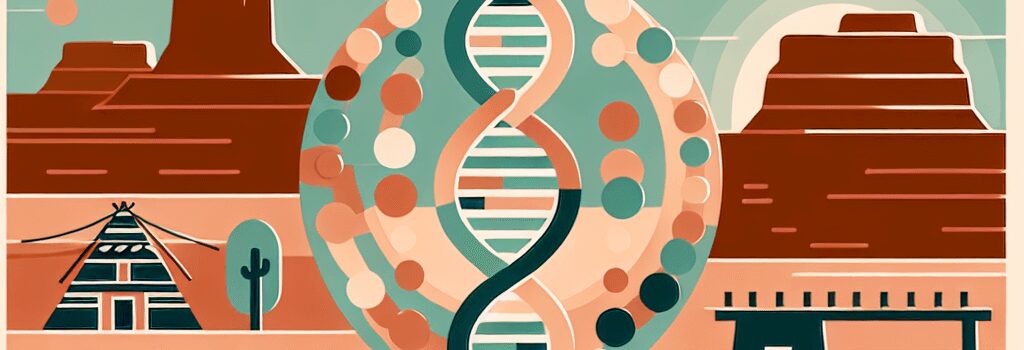Genomic Links Between Picuris Pueblo and Chaco Canyon Inhabitants

Archaeological Context and Oral Traditions
Chaco Canyon, in present-day northwestern New Mexico, was a major center of Ancestral Puebloan civilization between AD 850 and 1150. The site’s monumental stone great houses, intricate kivas, and extensive road network testify to an advanced society with far-flung trade contacts reaching as far as Mesoamerica. Yet by the mid-12th century, these great houses were largely abandoned, leaving open questions about where its people migrated.
Meanwhile, small multi-room pueblos emerged in the northern Rio Grande Valley—today’s Picuris Pueblo among them. Continuously inhabited for over 700 years, Picuris Pueblo retained oral histories linking its founders to the great builders of Chaco. To date, pinpointing a direct ancestral line through archaeology alone has proved elusive.
Methodology: Ancient DNA Extraction and Sequencing
In a landmark, pueblo-driven effort published in Nature (2025), researchers from the Center for GeoGenetics (University of Copenhagen) and the Picuris Pueblo government collaborated on an ancient DNA (aDNA) study. Key technical steps included:
- Sample Collection: Cortical bone samples from seven human remains (dated 500–700 years BP) were excavated under Pueblo supervision, alongside saliva samples from 15 present-day Picuris volunteers.
- aDNA Library Preparation: Single-stranded DNA library protocols minimized loss of ultra-short fragments. Researchers applied partial uracil-DNA glycosylase (UDG) treatment to remove deaminated cytosines that cause C→T misincorporations, improving data accuracy.
- Target Enrichment: In-solution hybridization capture targeted a panel of ~1.2 million genome-wide SNPs used in global population genetics, achieving on-target rates above 60% despite low endogenous DNA content (~2–5%).
- High-Throughput Sequencing: Libraries were sequenced on an Illumina NovaSeq 6000 platform, generating ~1× average coverage per ancient genome and ~30× coverage for modern samples.
- Contamination Control: Mitochondrial DNA consensus sequences and X-chromosome heterozygosity metrics confirmed contamination levels below 2% in all ancient samples.
Data Analysis: Bioinformatics and Statistical Genomics
Advanced computational methods traced shared ancestry and population splits:
- PCA and ADMIXTURE: Principal component analysis positioned Picuris individuals within the Southern Native American genetic cluster, while ancestral component modeling (ADMIXTURE at K=6) revealed a unique genetic signature shared with Chaco Canyon remains.
- f4-statistics and D-statistics: Formal tests of admixture (e.g., f4(Picuris_ancient, Chaco_Bonito; Other Pueblo, Outgroup)) yielded Z-scores >5, confirming a stronger genetic affinity between Picuris and Chaco than with any other sampled group.
- Local Ancestry Inference: Phasing modern genomes and scanning for segments >1 cM that coalesce with ancient haplotypes estimated a genetic continuity of ~70–80% over the last seven centuries.
Additional Context: Regional Population Dynamics
Beyond the Chaco-Picuris connection, the study integrates latest findings on the peopling of North America. It supports a model in which all Southern Native Americans (including Clovis New Mexico) derive from an early split with northern Athabaskan groups, followed by diversification into distinct branches. One such branch, still poorly documented archaeogenetically, appears to have seeded the Pueblo-building cultures.
Recent saline stable isotope analyses of Chaco and Rio Grande ceramics suggest shifts in maize cultivation practices that may correlate with population movements. When coupled with genome data, these isotopic profiles offer a richer reconstruction of dietary adaptation and mobility patterns in the 12th–13th centuries.
Implications and Future Directions
This pueblo-led initiative marks a paradigm shift in how archaeogenetics engages with Indigenous communities. By ensuring tribal leadership in sample selection, research questions, and data stewardship, the collaboration honors oral histories alongside scientific inquiry.
Looking ahead, expanding genomic sampling to other northern Rio Grande Pueblos and refining local ancestry methods could reveal finer details of post-Chaco migrations. Additionally, integrating paleoclimatic reconstructions and network science analyses of ancient roads may uncover social dynamics that drove population dispersals.
As technical advances—such as long-read aDNA sequencing and machine-learning–driven imputation—continue to lower costs and boost resolution, archaeogenetic studies co-designed with native stakeholders promise to deepen our understanding of North America’s complex human past.